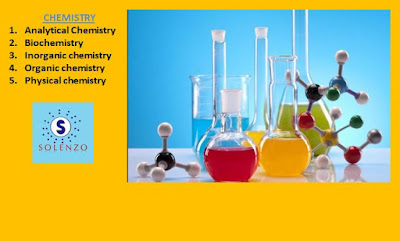Although many would say that there are FIVE main branches of chemistry, namely: Physical, Analytical, Biochemistry, Organic and Inorganic chemistry many would
argue that the science of chemistry actually links out to other branches or sub-branches that include Materials Chemistry, Theoretical Chemistry, Macromolecular (Polymer) Chemistry, Nuclear Chemistry, Metallurgy, Forensic Chemistry, Medicinal Chemistry and more.It is important to note that often sub-branches fall under one or more of the main branches of chemistry.
Let’s start by taking a look at the 5 main branches of chemistry and then delve deeper into chemistry’s many sub-branches:
Analytical Chemistry
Analytical chemistry is the branch of chemistry involving in chemical characterization of matters either quantitatively or qualitatively; e.g. How much caffeine is really in a cup of coffee? Are there drugs found in athlete’s urine samples? What is the pH level of my swimming pool? Examples of areas using analytical chemistry include forensic science, environmental science, drug and food testing and general goods manufacturing industries.
Analytical chemistry is divided into two main branches: qualitative and quantitative analysis.
Qualitative analysis employs methods/measurements to help determine the components of substances. Quantitative analysis on the other hand, helps to identify how much of each component is present in a substance.
Both types of analysis can be used to provide important information about an unidentified sample and help to identify what the sample is.
Biochemistry
The chemistry of life or more aptly put, of chemical processes in living organisms. Biochemists research includes cancer and stem cell biology, infectious disease as well as membrane and structural biology and spans molecular biology, genetics, mechanistic biochemistry, genomics, evolution and systems biology.
Biochemistry, according to many scientists can also be explained as a discipline in which biological phenomena are examined in chemical terms.
Examples are digestion and cellular respiration.
For this reason biochemistry is also known as Chemical Biology or Biological Chemistry.
Under the main umbrella of biochemistry many new sub-branches have emerged that modern chemists may specialize in solely. Some of these disciplines include:
1. Enzymology (study of enzymes)
2. Endocrinology (study of hormones)
3. Clinical Biochemistry (study of diseases)
4. Molecular Biochemistry (Study of Biomolecules and their functions).
There are also others like Pharmacological Biochemistry, Agricultural Biochemistry and more.
Inorganic chemistry
Branch of chemistry that focus on elements and compounds other than carbon or hydrocarbons.
Simply put, inorganic chemistry covers all materials that are not organic and are termed as non-living substances – those compounds that do not contain a carbon hydrogen (C-H) bond.
Compounds studied by inorganic chemists include crystal structures, minerals, metals, catalysts, and most elements on the periodic table.
An example is the strength of a power beam used to carry a specific weight or investigating how gold is formed in the earth,
Branches of inorganic chemistry include:
1. Bioinorganic chemistry (study of role of metals in biology)
2. Coordination chemistry (study of coordination compounds and interactions of ligands)
3. Geochemistry (study of the earth’s chemical composition, rocks, minerals & atmosphere)
4. Inorganic technology (synthesizing new inorganic compounds)
5. Nuclear chemistry (study of radioactive substances)
6. Organometallic chemistry (study of chemicals that contain bonds between a metal and carbon – overlaps into organic chemistry)
7. Solid-state chemistry/materials chemistry (study of the forming, structure, and characteristics of solid phase materials)
8. Synthetic inorganic chemistry (study of synthesizing chemicals)
9. Industrial inorganic chemistry (study of materials used in manufacturing. E.g.: fertilizers)
Organic chemistry
The study of carbon compounds such as fuels, plastics, food additives, and drugs.
An opposite of inorganic chemistry that focuses on non-living matter and non-carbon based substances, organic chemistry deals with the study of carbon and the chemicals in living organisms.
An example is the process of photosynthesis in a leaf because there is a change in the chemical composition of the living plant.
Organic chemists are often the ones who devise experimental methods to isolate or synthesize new materials, or to study their properties, and usually work and research in a lab. Some examples on the work they do include formulating a conditioner that keeps hair softer, developing a better drug for headaches and creating a non-toxic home cleaning product.
The branches of organic chemistry involve many different disciplines including the study of ketones, aldehydes, hydrocarbons (alkenes, alkanes, alkynes) and alcohols.
1. Stereochemistry (study of the 3-dimensional structure of molecules)
2. Medicinal chemistry (deals with designing, developing and synthesizing pharmaceutical drugs)
3. Organometallic chemistry (study of chemicals that contain bonds between a carbon and a metal)
4. Physical organic chemistry (study of structure and reactivity in organic molecules)
5. Polymer chemistry (study of the composition and creation of polymer molecules)
Physical chemistry
The study of the physical properties of molecules, and their relation to the ways in which molecules and atoms are put together. Physical chemistry deals with the principles and methodologies of both chemistry and physics and is the study of how chemical structure impacts physical properties of a substance. An example is baking brownies, as you’re mixing materials and using heat and energy to get the final product.
Physical chemists would typically study the rate of a chemical reaction, the interaction of molecules with radiation, and the calculation of structures and properties.
Sub-branches of physical chemistry include:
1. Electrochemistry (study of the interaction of atoms, molecules, ions and electric current)
2. Photochemistry (study of the chemical effects of light; photochemical reactions)
3. Surface chemistry (study of chemical reactions at interfaces)
4. Chemical Kinetics (study of rates of chemical reactions)
5. Thermodynamics/Thermochemistry (study of how heat relates to chemical change)
6. Quantum Mechanics/Quantum Chemistry (study of quantum mechanics and how it relates to chemical phenomena)
7. Spectroscopy (study of spectra of light or radiation)
This article is developing so i suggest you bookmark it for future reference

Comments
Post a Comment